
I’ve always used a UPS (Uninterruptable Power Supply) to protect my Mac and peripherals from loss of power, electrical surges, brownouts, and noise and glitches on the power coming into my Mac. Having this basic protection had likely kept me from losing data when power failures occurred, extended the life of my Mac, and allowed me to laugh in the face of danger, or at least the thunderstorm heading our way.
A UPS is something that everyone should have to protect his or her computer(s) and equipment. In this Rocket Yard guide, we’ll take a look at UPS basics, features, and how to size a UPS for your needs. In today’s work from home (WFH) environment, it is more necessary than ever.
UPS: An Introduction
At its most basic, a UPS is a battery-powered system used to provide the needed electricity to your Mac and peripherals should the normal power fail. The UPS monitors the incoming utility power, and should it go down quickly, switches the power source to its internal battery. This prevents a sudden shutdown and the stress it can cause to your Mac and peripherals. It also gives you time to save the data in open applications and perform a controlled shutdown of your Mac.
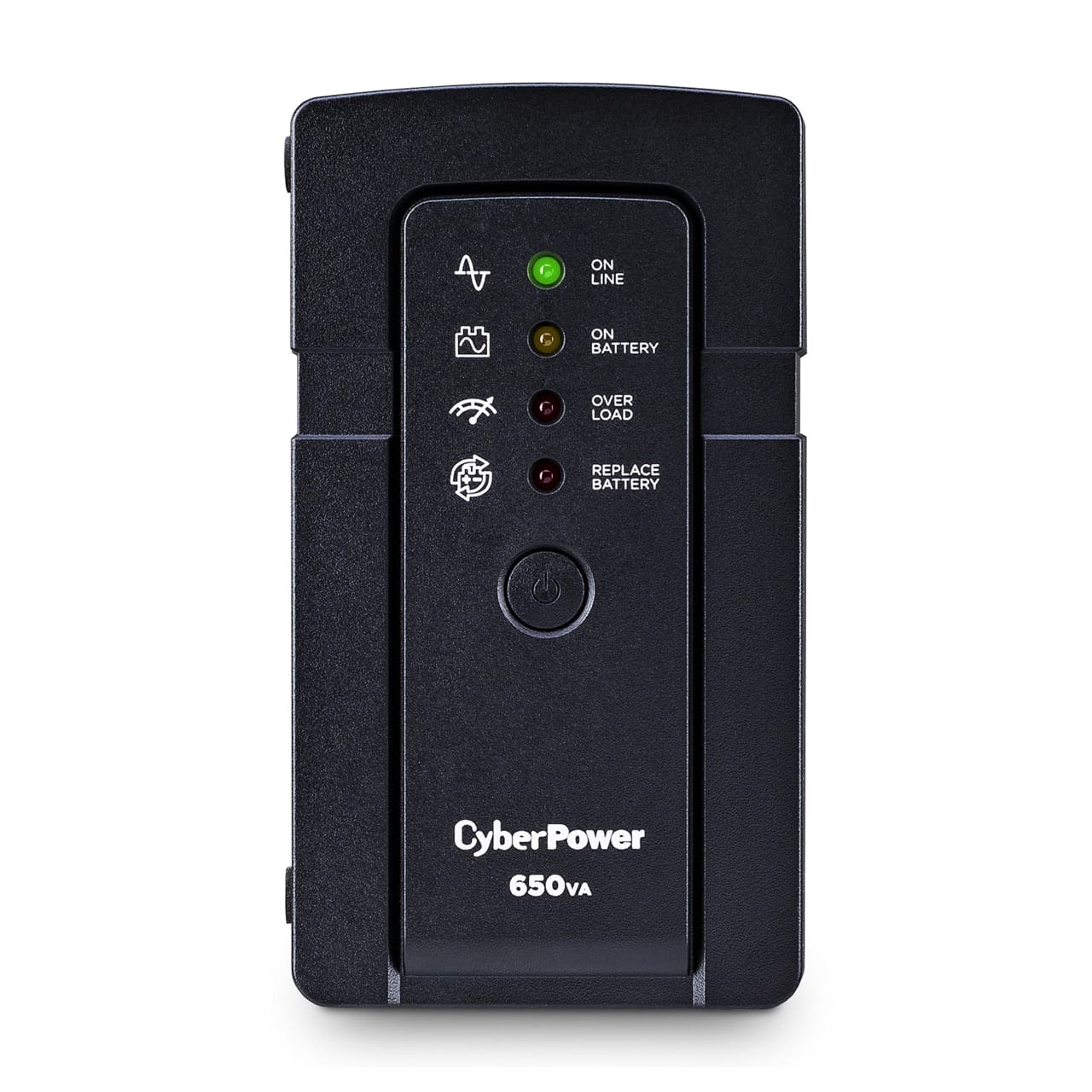
By avoiding the perils associated with suddenly losing power, a UPS can prevent data loss, corruption of files and the system, damaged components, and a shortened lifespan.
UPS devices also have built-in surge protection to handle routine electrical surges that often occur in commercial and residential settings.
UPS Types
UPS devices are usually available in three broad categories, with each type providing different levels of protection. Each UPS manufacturer may use a slightly different name for each category:
Standby UPS: This is the most basic type of UPS. It passes the utility power on to your Mac while monitoring the incoming voltage levels. If the incoming electrical levels fall below a predetermined level, the UPS changes the power source from the incoming utility voltage to the internal battery. Standby UPS usually can protect from surges, blackouts, and brownouts.
Line Interactive UPS: This type of UPS goes a bit further than the basic type. It monitors the incoming voltage for surges, blackouts, and brownouts, but it will also use the internal battery to supplement under-voltage conditions, and prevent over-voltage conditions from being passed on the devices connected to the UPS. You can think of this UPS category as allowing connected devices to use the normal incoming utility power as long as it is stable and within acceptable levels, but as soon as those levels are overstepped, the internal battery takes over.
Double Conversion UPS: With this type of UPS, your connected devices always run off the internal battery of the UPS, regardless of the state of the incoming line. The incoming line voltage is used primarily to keep the battery charged. This type of UPS offers all the protection of the Line Interactive, as well as protection against most line noise, frequency variations, and harmonic distortions. It’s possible for a Double Conversion UPS to provide the cleanest power to your devices.
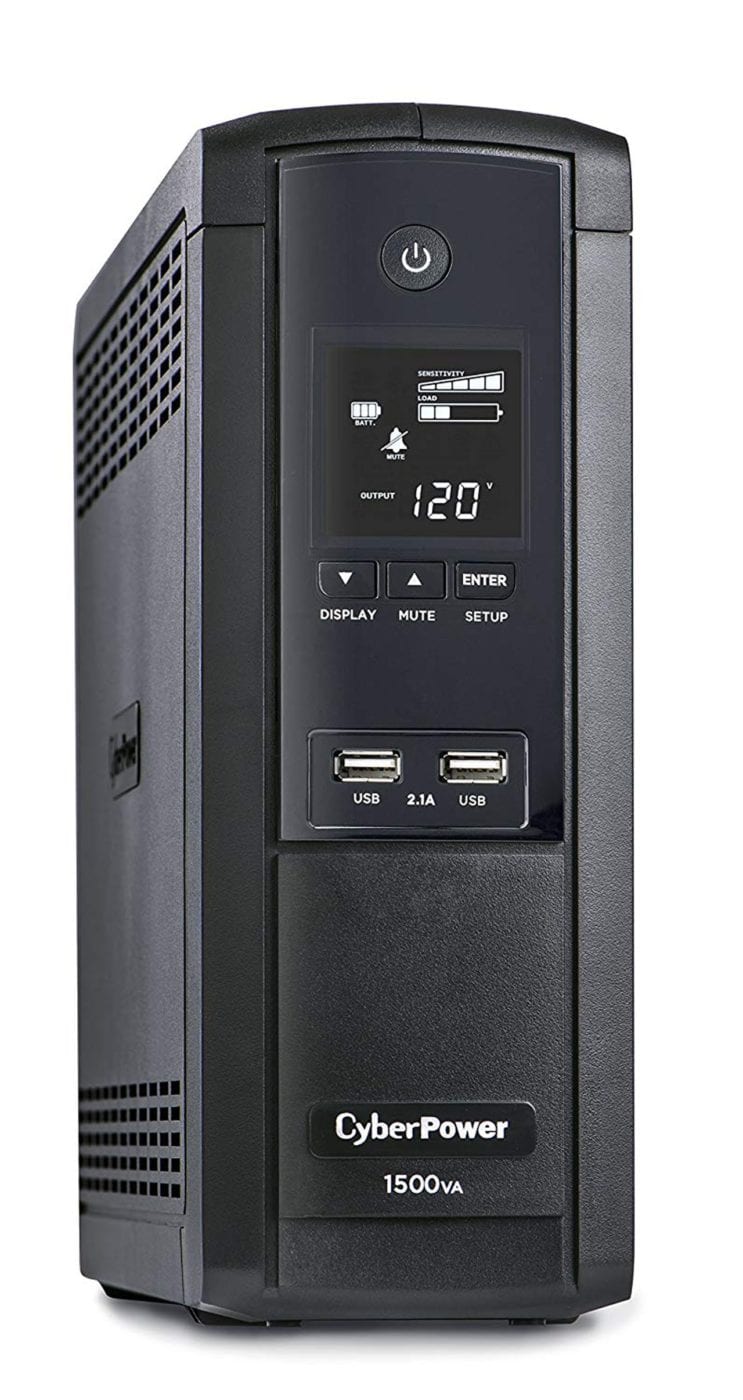
Which Type of UPS to Use?
Any UPS type is better than none, and each type can provide good service to your hardware, depending on the type of power problems you are likely to experience:
Stable electrical environment: This is likely a residential setting in an urban or suburban area. The power tends to stay on year-round but may go off if a big storm rolls through. You don’t have industrial machinery operating nearby, and the biggest source of electrical noise is your refrigerator, washing machine, or AC turning on or off. In this type of environment, any of the UPS types will meet your needs, including the basic Standby UPS.
Mostly stable: You live in a residential setting in a suburban or rural environment. You may lose power once in a while from storms. You may be a good distance away from an electrical substation, or in the last group of homes on a power feed. You notice occasional brownouts when the weather is hot. You may also be near commercial or agricultural properties that use large electrical machinery. While the power stays on most of the time, it’s likely not very clean, having over- and under-voltage conditions. A Line Interactive or Double Conversion type of UPS is appropriate for this setting.
Mixed: The area you live in has enough power outages that you have, or are considering installing, a backup generator, or make use of alternate electrical energy sources. In this type of setting, your electrical system can experience line noise, frequency variations, and harmonic distortion. A Double Conversion UPS is the best choice for this environment.
Note: Not sure where you fall in the above list? A Line Interactive UPS is the most popular and meets the needs of most people.
Sizing a UPS
The UPS needs to be big enough to not only run all of the devices you connect to it but to allow for enough runtime after a power outage occurs to give you time to perform a controlled shutdown on all of the devices. To properly size a UPS, you will need to know the capacity of the UPS and the size of the load connected to it.

This would seem to be a trivial exercise; add up all the loads and compare that to the UPS capacity. The problem is that UPS capacity and device loads are usually measured in two or more different units. It’s not uncommon for your devices to use watts to indicate the load, and a UPS to use VA (Volt-Amps) to indicate capacity. The two measurements are not directly interchangeable, although sometimes they are. The key is a third measurement known as PF or Power Factor. Unfortunately, equipment manufacturers rarely publish the PF rating. That leads us to use a generalization that the wattage rating is generally 60 percent of the VA rating.
Note: Wattage ratings of your equipment can be found either on a sticker attached to the equipment, or in the device’s manual, technical specifications, or environmental report.
- MacBook Tech Specs
- MacBook Air Tech Specs
- MacBook Pro Tech Specs
- iMac Power Consumption
- iMac Pro Power Consumption
- Mac Pro Power Consumption
- Mac mini Power Consumption
As an example, the following desktop Mac with two external drives:
- 2019 27-inch iMac: 262 watts
- OWC Mercury Elite Pro Dual mini: 36 watts
- OWC Envoy Pro EX: 0 watts (bus-powered, included in iMac wattage)
Total wattage: 262 + 36 + 0 = 298
VA rating: 1.6 × 298 = 476.8
This results in a UPS with a minimum VA rating of 476.8. But that’s just the minimum; the next step is to determine the runtime and over-provisioning.
Runtime is how long you want the UPS to be able to run the connected load before it depletes the battery and turns itself and your system off. To calculate runtime, you need to know the efficiency rating of the UPS, another specification that’s rarely published. Instead, it’s easiest to use configuration tools provided by the UPS manufacturers
Over-provisioning is how much additional load you want to be able to add to your system without adversely affecting the UPS. Some manufacturers allow you to specify over-provisioning in their tools while others do not. If you don’t see an over-provisioning option, add additional wattage to represent items you may add in the future to the total wattage calculation above.
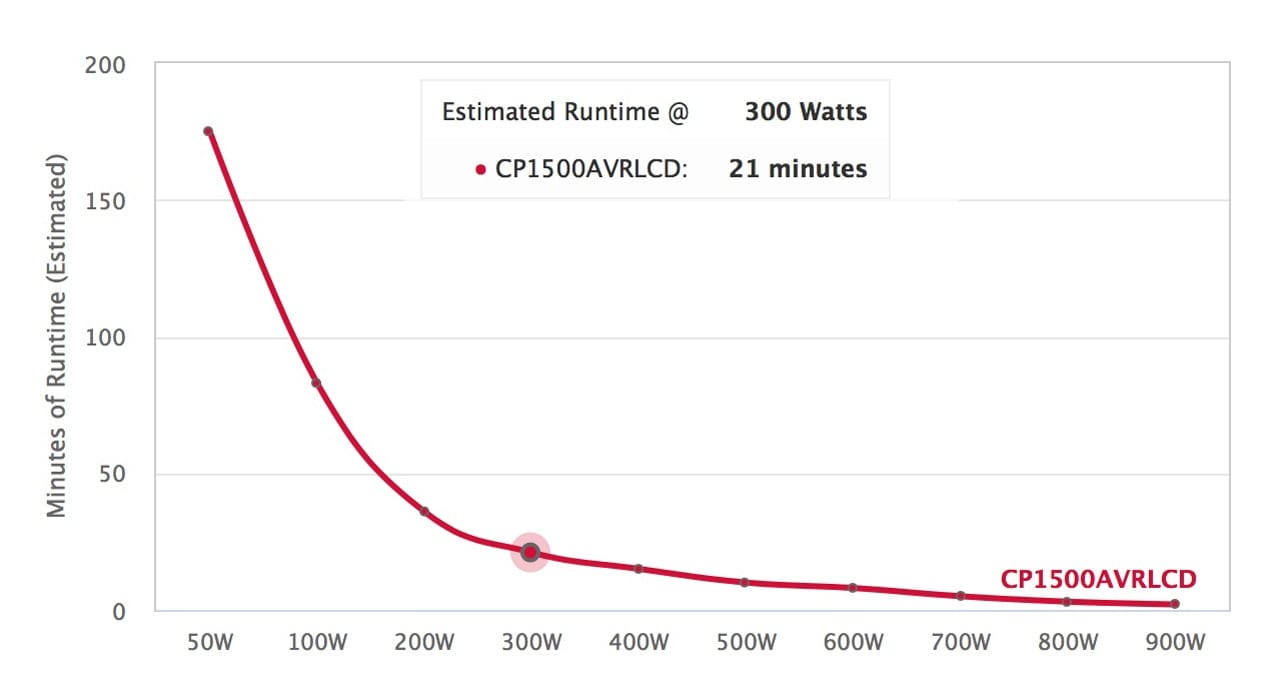
Additional UPS Features to Consider
There are additional UPS features you’ll need to consider, including some basic items, such as:
AVR: Short for Automatic Voltage Regulation. This feature is used to compensate for over- or under-voltage conditions. In most cases, a UPS with AVR will be a Line Interactive type of UPS.
Sine Wave or Simulated Sine Wave: The UPS battery’s output is DC and is converted by the UPS to either an approximation of an AC waveform (Simulated Sine Wave) or a true Sine Wave output. Some devices may require a true Sine Wave power source to operate correctly; this is especially true for devices that use active PFC (Power Factor Correcting) power supplies. Check with the device manufacturer to see if a true Sine Wave is required for the AC input, or if PFC power supplies are listed as a feature.
Software: Some UPS devices include an app that allows the UPS to communicate with your computer, informing the computer that the UPS is running on battery, how much runtime is left, and to initiate shutdown. The Mac has basic UPS support built-in, though the UPS software may offer more options. Using either the UPS-supplied or the Mac’s built-in power management software is a good idea, as it will allow for the Mac to be shut down gracefully during a power outage, even if you aren’t present.
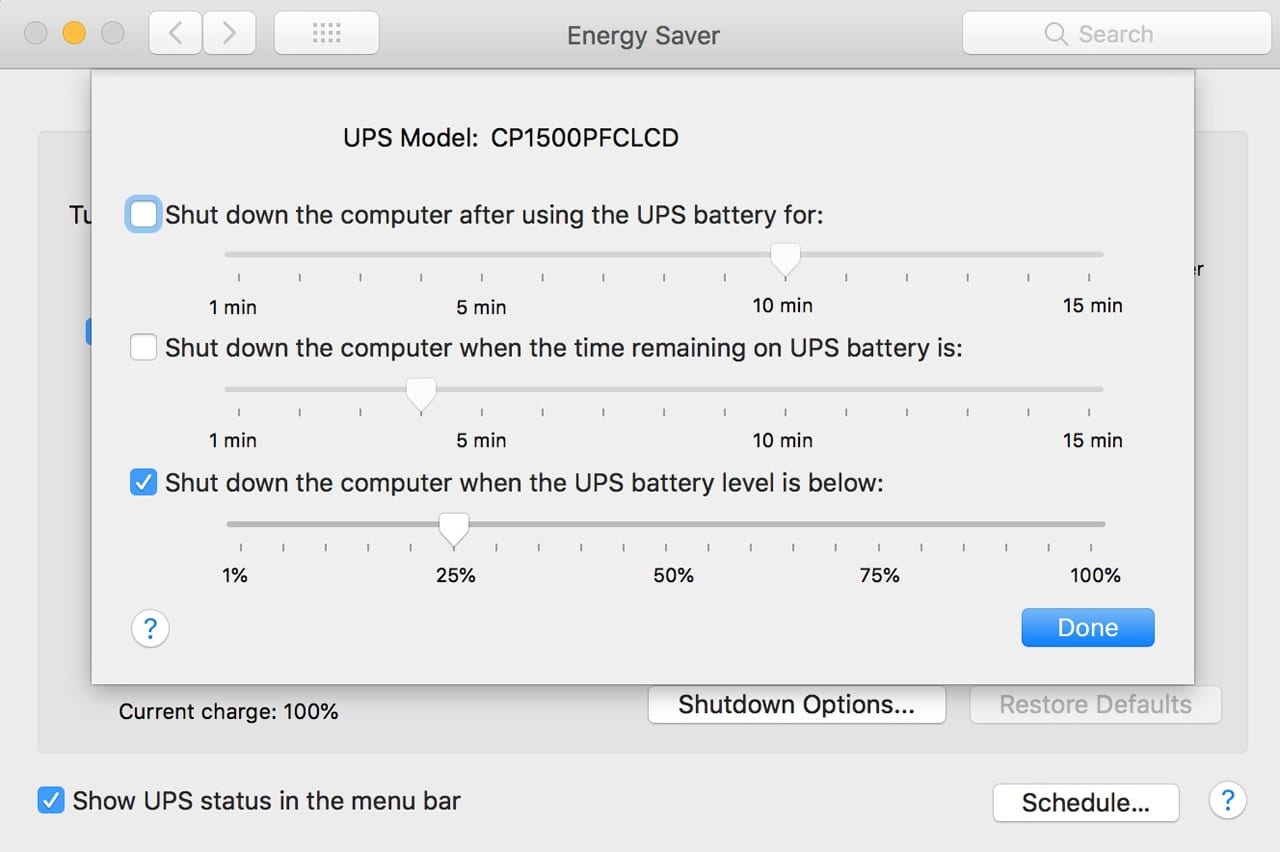
Power Outlets: Most UPS devices have a mix of outlets, some connected to the battery, and others that are just surge protected. Make sure the number of outlets matches up to your needs. Also, make sure the outlet arrangement will account for the use of power bricks your equipment may use.
Charging Port: A UPS may offer one or more USB ports specifically for charging mobile devices.
Noise: Larger UPS devices may have fans that can be annoyingly loud when you’re running on battery power. Check the manufacturer for noise ratings.
Alarms: A UPS may use an audible alarm to indicate that power has been removed, and the UPS is running off the battery. Check to see if the alarm can be disabled. It’s not pleasant to spend a night listening to the UPS alarm going off.
Displays: Some UPS devices include informational displays that indicate current conditions, such as voltage, battery charge, available runtime, and battery health.
Replaceable batteries: Batteries in UPS devices have a limited lifetime. Being able to replace the battery is a better choice than replacing an expensive UPS just because the battery has failed. In addition, some UPS devices allow you to add larger or multiple batteries to increase runtime.
USB: A UPS will usually communicate to the computer using a USB port. Make sure you have a free USB port on your Mac to support the UPS.
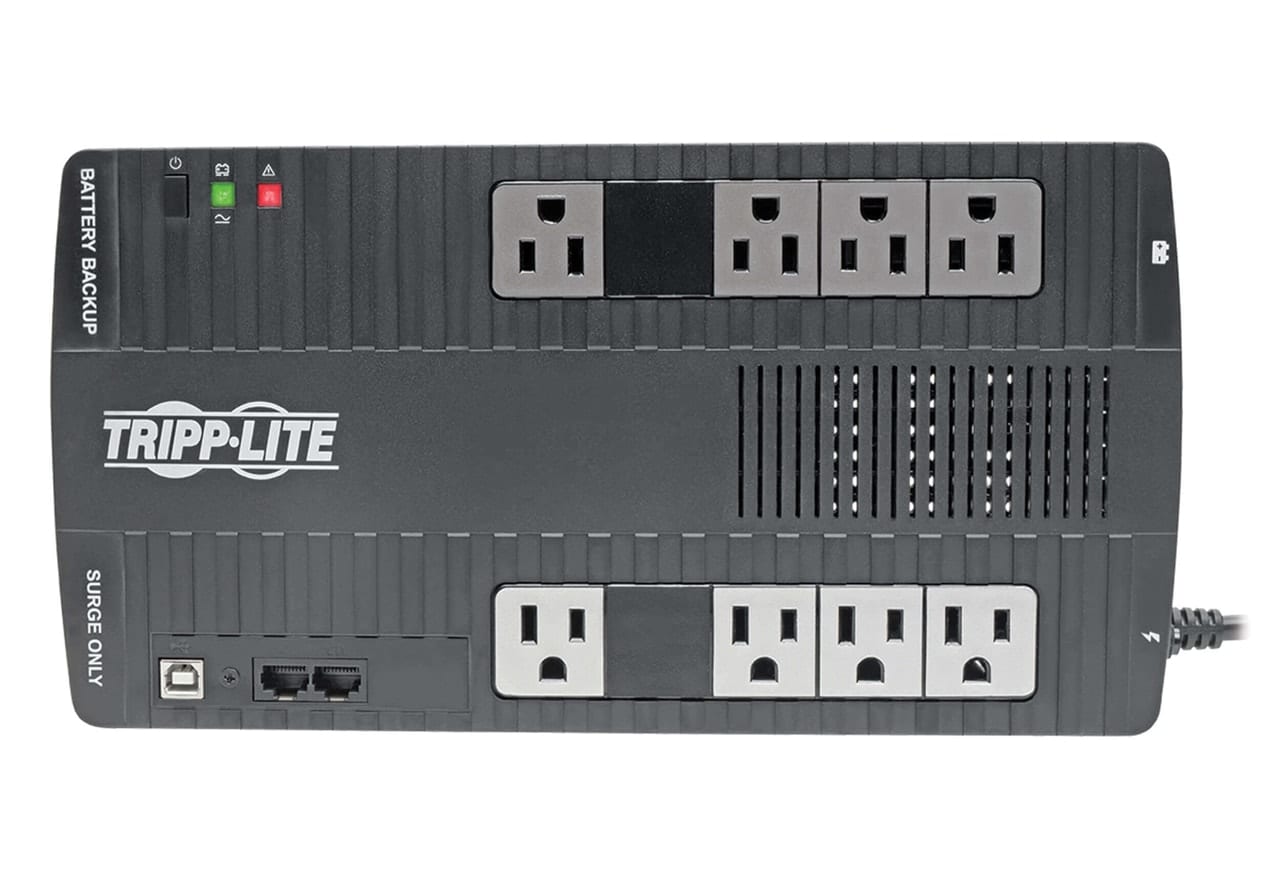
Other UPS Uses
So far, we’ve assumed that you’re using the UPS with your computer setup, but a UPS can be used to protect just about any type of electronic device, including TVs, home theater, security systems, networking equipment (routers, modems, wireless access points, switches), and gaming systems.
UPS usage has some restrictions; the consumer versions usually should not be used to power devices such as printers, copiers, and scanners that use motors or toner fusing systems. These types of devices tend to draw large amounts of energy in short bursts that can quickly overload a UPS. It’s OK to use UPS surge-only outlets to protect these devices, but don’t connect them to the battery outlets of the UPS.
What’s your experience with a UPS? Let us know in the comments below.
More Work From Home Essentials
- What You Need (And Need to Know) to Work From Home Successfully
- Use a Dock or Hub With Your Computer
- Choosing a UPS for Your Computer System
- FaceTime and Other Videoconference Apps
- Get More From Your Printer
- Helpful Apps and Utilities
- Photoshop Alternative – Affinity Photo
- InDesign Alternative – Affinity Publisher
- Illustrator Alternative – Affinity Designer
- Going Mobile While Staying Home










“””Hi
Your Blog is very informative I really appreciate it.
I have some Suggestions regarding Batteries
Here’s Everything You Need To Know Before Buying A UPS for Home
A UPS or uninterruptible power supply is a device that provides emergency power to an electronic system in the event of a power outage. UPS devices are commonly found in homes, hospitals, Banks, Industries,Educational Industries, factories and in many other places and organizations. They protect the devices from electrical spikes and surges as well as power outages so your electronics remain on.
A UPS is a perfect solution for your home or office. It will keep your electronics safe from power surges and spikes, as well as provide backup power during an outage.
We at MSP Web Store provides all type of UPS.”””
I like the article, but it does not really confirm, for me, that I must use a true sine wave UPS for my 27″ iMAC. Since this is an Apple Mac centric company, I was hoping that the article would come out and say that Mac computers DO use active PFC power supplies, and therefore need ( or at least work best with ) a full sine wave UPS. In fact, the illustration of “..built-in UPS power management” does indeed show a CyberPower unit that is full sine wave.
I guess I will continue to look for someone who has actually successfully tested a Line Interactive/AVR type UPS with a contemporary Mac Desktop. There is a much larger selection of Line Interactive type UPS’s including lower priced models.
Execellent article on UPS. I have utilized them for quite a long time and would add the remark to mark them with the month/year put into administration. Extremely simple to fail to remember when you added them to your framework.
Likewise if the most exceedingly terrible happens make a point to keep your receipt and document the case on the guarantee. I had an easing up strike and the warrant paid for the harmed printer and supplanted the UPS!
wow you said is almost very nice i have written same article on https://www.excelwaxel.com/event-budget-template/
check this side and tell me if i need any improvement here
When I was planning to buy a UPS even I had qualms about features of a UPS and whether it is good for me or not. Then I found out about Power Calculator which helped me a lot and I decided to buy a UPS as per my requirements.
You can use calculate your power at https://mspwebstore.com/power
It’s good to know that the UPS system could also protect your gaming system and security system during a power outage. I’ve always thought the UPS system could only be used with the computer set up. But now that I know that it could also protect a security system, perhaps I should buy one soon since we have one installed at home. Thanks.
I had a branded, heavy and somewhat expensive UPS 6 or 7 years ago and wasnt happy with it. But these days, why bother with one when you can choose from a wide range of portable power stations that are reasonably priced and do a whole lot more than just give you a few minutes for you shut down safely. Why shut down when you can just keep going for hours?
I have really note as you too,
we need a check..
Very informative and concise article. Thank you.
Please note there is an error in calculating the minimum VA capacity of the UPS. You should divide by 0.6, instead of multiplying by 1.6, as the maximum wattage from the load would be 0.6 of the minimum VA capacity. The resulting number will be 6.7% higher.
good point
Execellent article on UPS. I have used them for years and would add the comment to label them with the month/year put into service. Very easy to forget when you added them to your system.
Also if the worst happens make sure to keep your receipt and file the claim on the warranty. I had a lightening strike and the warrant paid for the damaged printer and replaced the UPS!